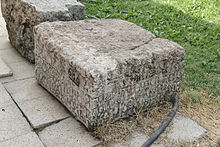Inscription Ancoz 7
An inscription in Luwian hieroglyphs from the 9th / 8th centuries is used as Ancoz 7 . Century BC Chr. From the commagenic settlement hill Ancoz , which is exhibited in the Archaeological Museum Adıyaman .
origin
The inscription stone was found in 1979 by the Turkish Hittiteologist Sedat Alp during his excavations on the hill of Ancoz. The hill is located near the present-day village of Eskitaş in the Kâhta district of the Turkish province of Adıyaman , it is now flooded by the Ataturk reservoir . It was in use from the Neo-Hittite period (1200–700 BC) and belonged to the Iron Age kingdom of Kummuh , which roughly corresponds to the later Commagene. The inscription is located outside the Archaeological Museum of the provincial capital Adıyaman and has the inventory number 686. It was first published in 2000 by John David Hawkins in his Corpus of Hieroglyphic Luwian Inscriptions , where it was named Ancoz 7 .
description
The square stone block has sides of 0.75 meters and a preserved height of 0.40 meters. It is completely surrounded by a single-line, left-hand inscription in Luwian hieroglyphics. It can be seen from the sparse remains that it originally had a second line of writing above it. Since almost all of the found inscriptions from Ancoz (Ancoz 1, 5, 8 , 9 , 10 ) were in two lines, it is assumed that there were no further ones here either. Since the text ends on the left on page D, Hawkins suspects that he began over it, went right over the pages DCBA, and then turned to the left. The mostly well-preserved inscription is executed in relief, the line height is 20 centimeters. The lower part of the stone is unlabeled.
In the text the author describes himself as Suppiluliuma, his son Hattusili is also mentioned, whereby the document refers to the reign of Suppiluliuma at the end of the 9th and beginning of the 8th century BC. Can be dated BC. There is also talk of gifts from “these cities” to the deer god , the goddess ATA Kubaba ( Ala ), the sun god , as well as the gods Ikuras and Taskus. In the usual final formula of the curse, those who do not follow the instructions are removed from this tablet or the names of the Suppiluliuma or Hattusilis are destroyed and threatened with persecution by the gods mentioned.
literature
- John David Hawkins: Corpus of hieroglyphic Luwian inscriptions . Vol 1. Inscriptions of the Iron Age . Part 1: Introduction, Karatepe, Karkamiš, Tell Ahmar, Maraş, Malatya, Commagene. de Gruyter, Berlin 2000, ISBN 3-11-010864-X , pp. 356–357, plates 185–186.
Web links
Individual evidence
- ^ J. David Hawkins: Gods of Commagene: The Cult of the Stag-God in the inscriptions of Ancoz In: Eva Cancik-Kirschbaum , Jörg Klinger, Gerfrid GW Müller: Diversity and Standardization: Perspectives on ancient Near Eastern cultural history Walter de Gruyter , 2013 ISBN 9783050057576 pp. 73-74




